warning FIAT 500E 2013 2.G User Guide
[x] Cancel search | Manufacturer: FIAT, Model Year: 2013, Model line: 500E, Model: FIAT 500E 2013 2.GPages: 84, PDF Size: 1.56 MB
Page 2 of 84
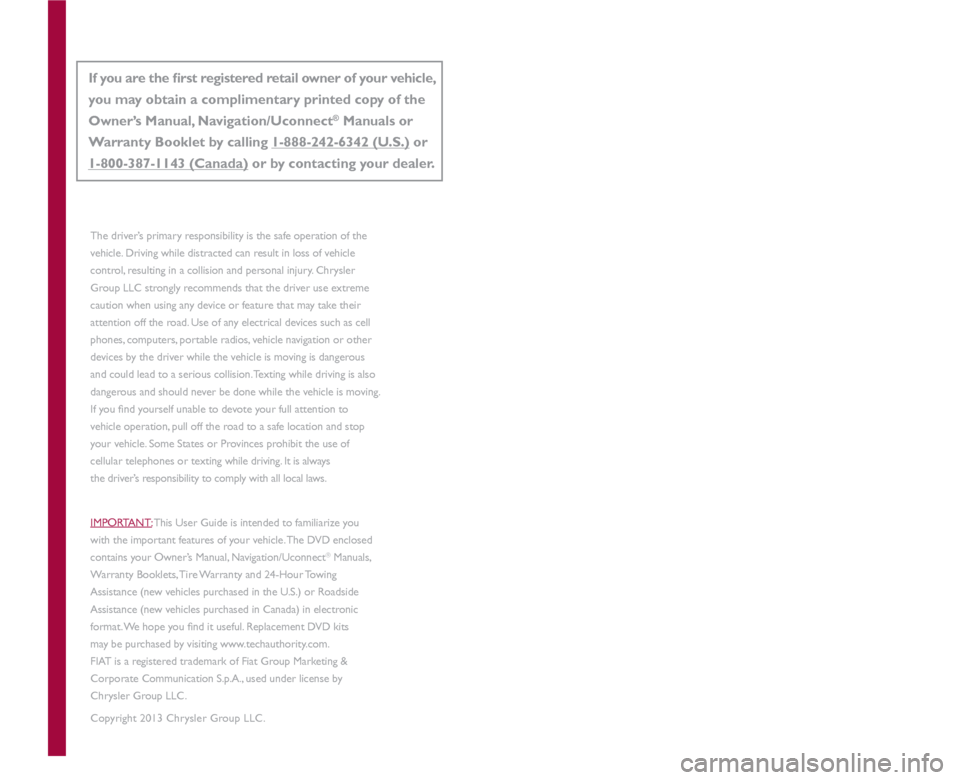
If you are the first registered retail owner of your vehicle,
you may obtain a complimentary printed copy of the
Owner’s Manual, Navigation/Uconnect
® Manuals or
Warranty Booklet by calling 1-888-242-6342 (U.S.) or
1-800-387-1143 (Canada) or by contacting your dealer.
WARNING
This guide has been prepared to help you get quickly acquainted with
your new F
IAT
and to provide a convenient reference source for common
questions. However, it is not a substitute for your Owner’s Manual.
For complete operational instructions, maintenance procedures and
important safety messages, please consult your Owner’s Manual,
Navigation/Uconnect
® Manuals and other Warning Labels in your vehicle.
Not all features shown in this guide may apply to your vehicle. For
additional information on accessories to help personalize your vehicle, visit
www.mopar.com (U.
s
.), www.mopar.ca (Canada) or your local FIAT studio.
1380029_13c_500e_UserGuide_050613.indd 25/6/13 11:54 AM
The driver
Page 3 of 84
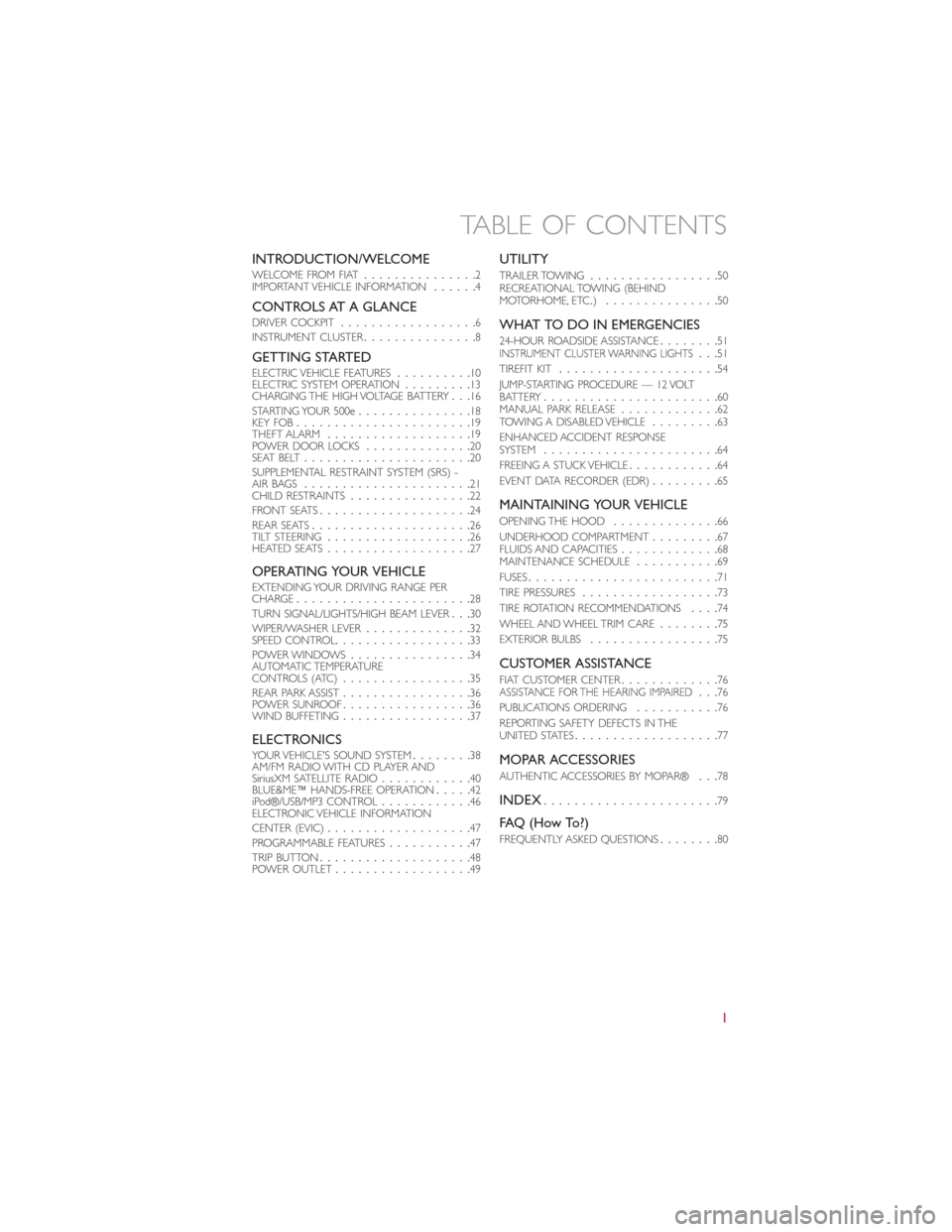
INTRODUCTION/WELCOMEWELCOME FROM FIAT...............2
IMPORTANT VEHICLE INFORMATION ......4
CONTROLS AT A GLANCEDRIVER COCKPIT .................. 6
INSTRUMENT CLUSTER ...............8
GETTING STARTEDELECTRIC VEHICLE FEATURES ..........10
ELECTRIC SYSTEM OPERATION .........13
CHARGING THE HIGH VOLTAGE BATTERY ...16
STARTING YOUR 500e ............... 18
KEY FOB ....................... 19
THEFT ALARM ................... 19
POWER DOOR LOCKS ..............20
SEAT BELT ...................... 20
SUPPLEMENTAL RESTRAINT SYSTEM (SRS) -
AIR BAGS ...................... 21
CHILD RESTRAINTS ................ 22
FRONT SEATS .................... 24
REAR SEATS ..................... 26
TILT STEERING ................... 26
HEATED SEATS ................... 27
OPERATING YOUR VEHICLEEXTENDING YOUR DRIVING RANGE PER
CHARGE....................... 28
TURN SIGNAL/LIGHTS/HIGH BEAM LEVER ...30
WIPER/WASHER LEVER ..............32
SPEED CONTROL .................. 33
POWER WINDOWS ................ 34
AUTOMATIC TEMPERATURE
CONTROLS (ATC) ................. 35
REAR PARK ASSIST ................. 36
POWER SUNROOF ................. 36
WIND BUFFETING ................. 37
ELECTRONICSYOUR VEHICLE'S SOUND SYSTEM ........38
AM/FM RADIO WITH CD PLAYER AND
SiriusXM SATELLITE RADIO ............40
BLUE&ME™ HANDS-FREE OPERATION .....42
iPod®/USB/MP3 CONTROL ............46
ELECTRONIC VEHICLE INFORMATION
CENTER (EVIC) ................... 47
PROGRAMMABLE FEATURES ...........47
TRIP BUTTON .................... 48
POWER OUTLET .................. 49
UTILITY
TRAILER TOWING................. 50
RECREATIONAL TOWING (BEHIND
MOTORHOME, ETC .)............... 50
WHAT TO DO IN EMERGENCIES
24-HOUR ROADSIDE ASSISTANCE ........51INSTRUMENT CLUSTER WARNING LIGHTS...51
TIREFIT KIT ..................... 54
JUMP-STARTING PROCEDURE — 12 VOLT
BATTERY ....................... 60
MANUAL PARK RELEASE .............62
TOWING A DISABLED VEHICLE .........63
ENHANCED ACCIDENT RESPONSE
SYSTEM ....................... 64
FREEING A STUCK VEHICLE ............64
EVENT DATA RECORDER (EDR) .........65
MAINTAINING YOUR VEHICLE
OPENING THE HOOD ..............66
UNDERHOOD COMPARTMENT .........67
FLUIDS AND CAPACITIES .............68
MAINTENANCE SCHEDULE ...........69
FUSES ......................... 71
TIRE PRESSURES .................. 73
TIRE ROTATION RECOMMENDATIONS ....74
WHEEL AND WHEEL TRIM CARE ........75
EXTERIOR BULBS ................. 75
CUSTOMER ASSISTANCE
FIAT CUSTOMER CENTER.............76ASSISTANCE FOR THE HEARING IMPAIRED...76
PUBLICATIONS ORDERING ...........76
REPORTING SAFETY DEFECTS IN THE
UNITED STATES ................... 77
MOPAR ACCESSORIES
AUTHENTIC ACCESSORIES BY MOPAR® ...78
INDEX....................... 79
FAQ(HowTo?)
FREQUENTLY ASKED QUESTIONS........80
TABLE OF CONTENTS
1
Page 7 of 84
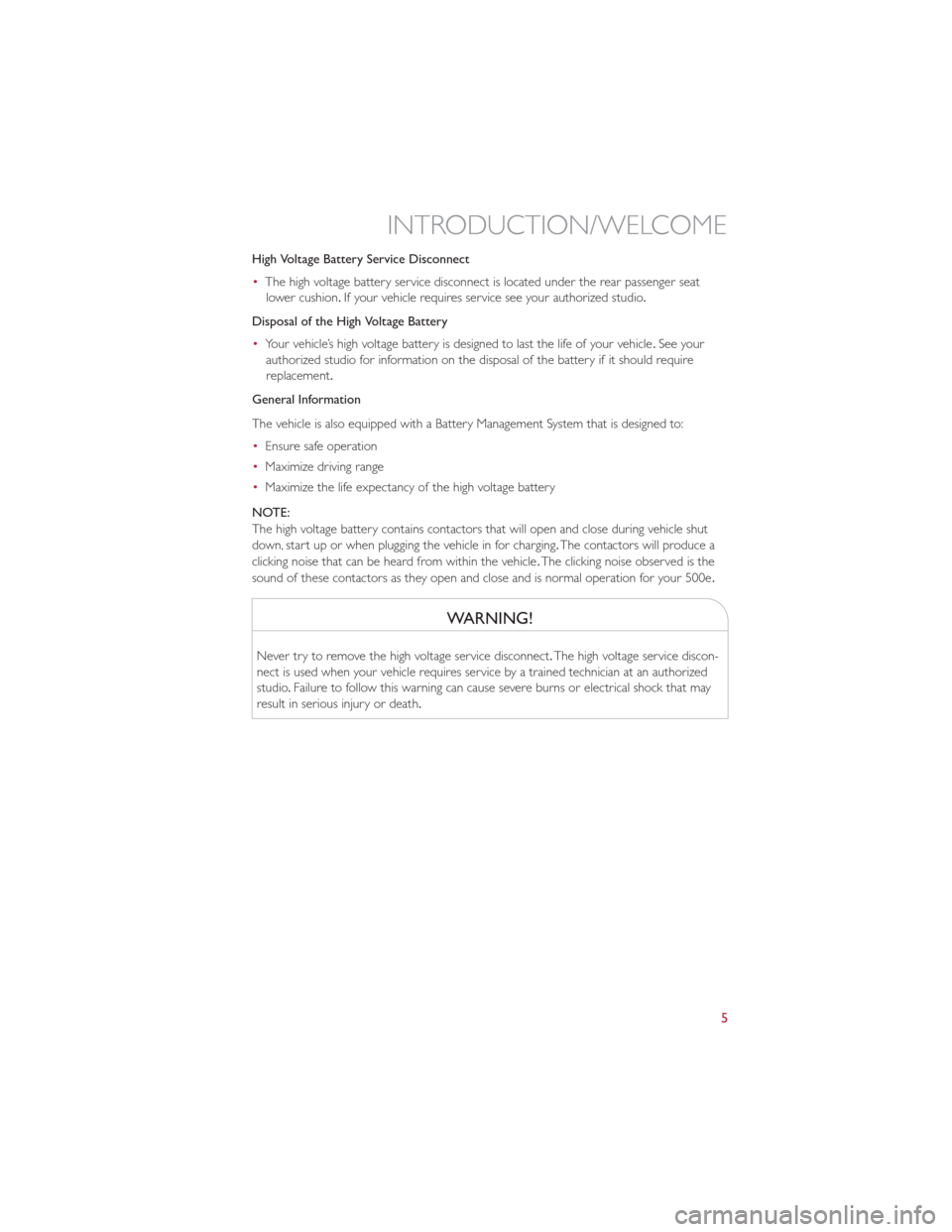
High Voltage Battery Service Disconnect
•The high voltage battery service disconnect is located under the rear passenger seat
lower cushion. If your vehicle requires service see your authorized studio .
Disposal of the High Voltage Battery
• Your vehicle’s high voltage battery is designed to last the life of your vehicle .See your
authorized studio for information on the disposal of the battery if it should require
replacement.
General Information
The vehicle is also equipped with a Battery Management System that is designed to:
• Ensure safe operation
• Maximize driving range
• Maximize the life expectancy of the high voltage battery
NOTE:
The high voltage battery contains contactors that will open and close during vehicle shut
down, start up or when plugging the vehicle in for charging. The contactors will produce a
clicking noise that can be heard from within the vehicle .The clicking noise observed is the
sound of these contactors as they open and close and is normal operation for your 500e .
WARNING!
Never try to remove the high voltage service disconnect.The high voltage service discon-
nect is used when your vehicle requires service by a trained technician at an authorized
studio .Failure to follow this warning can cause severe burns or electrical shock that may
result in serious injury or death.
INTRODUCTION/WELCOME
5
Page 10 of 84
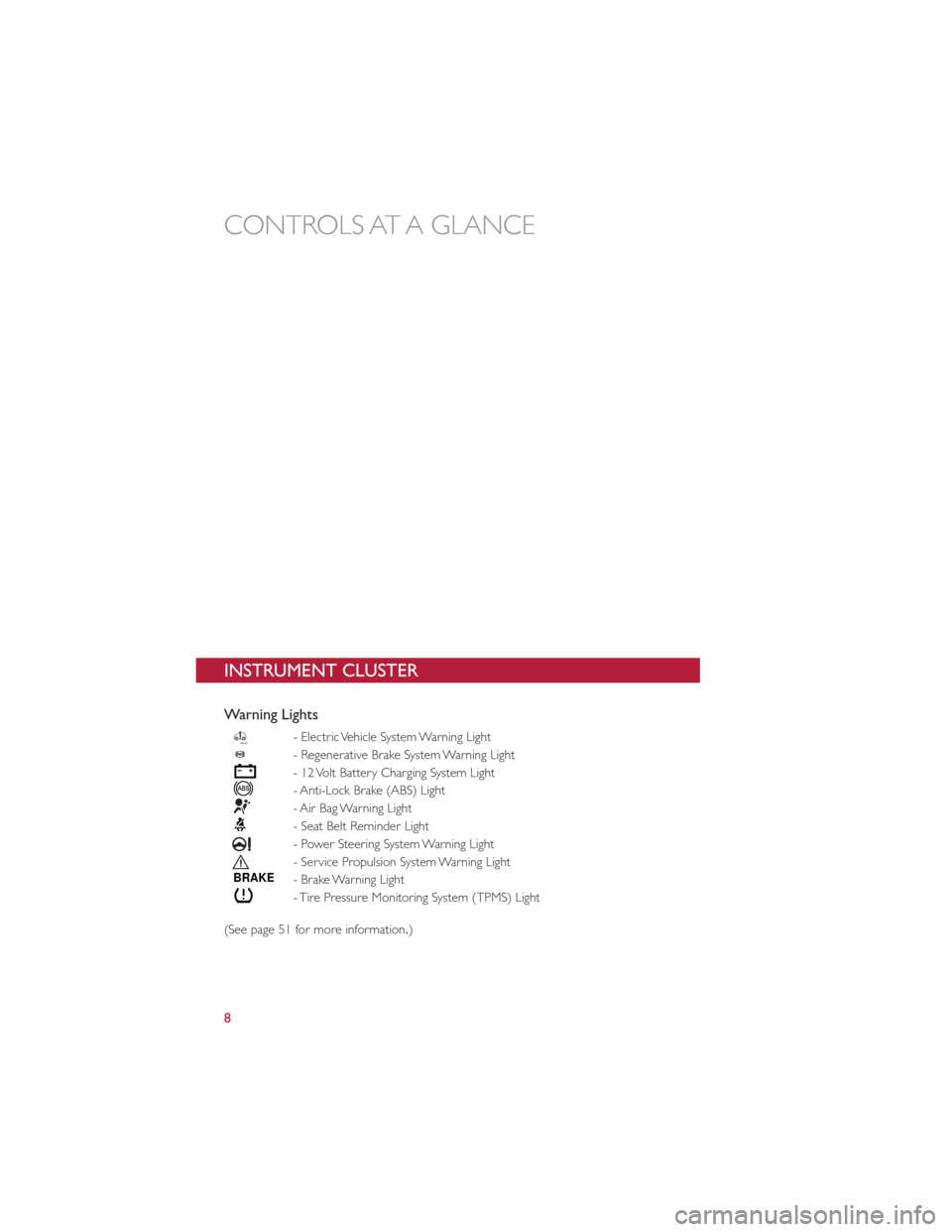
INSTRUMENT CLUSTER
Warning Lights
- Electric Vehicle System Warning Light
- Regenerative Brake System Warning Light
- 12 Volt Battery Charging System Light
- Anti-Lock Brake (ABS) Light
- Air Bag Warning Light
- Seat Belt Reminder Light
- Power Steering System Warning Light
- Service Propulsion System Warning Light
BRAKE- Brake Warning Light
- Tire Pressure Monitoring System (TPMS) Light
(See page 51 for more information.)
CONTROLS AT A GLANCE
8
Page 12 of 84

ELECTRIC VEHICLE FEATURES
Auto Park
•The Auto Park features automatically places the transmission into PARK if there is any
indication that the driver may leave the vehicle while the transmission is in D (DRIVE),
N (NEUTRAL) or R (REVERSE).
• Auto Park is enabled under the following conditions:
• Key On (12 Volt ON and High Voltage OFF) or READY mode (12 Volt ON and High
Voltage ON).
• Vehicle speed is below 2 mph (3 km/h).
NOTE:
Auto Park is disabled above 2 mph (3 km/h) and transmission range will be maintained.
• The instrument cluster will display an Auto shift to park message and chime once when
Auto Park action occurs.
Mode of operation with key ON
• Auto Park will be engaged when the transmission is in DRIVE, NEUTRAL or REVERSE
and the following conditions are detected:
• Seat Belt is unlatched
• Brake pedal is released
• Driver's door is ajar
Mode of operation with key OFF
• Auto Park will be engaged when the transmission is in D (DRIVE), N (NEUTRAL) or
R (REVERSE) and the vehicle speed is less than 2 mph (3 km/h).
Audible Pedestrian Warning System
• Your vehicle is equipped with an Audible Pedestrian Warning System. The Audible
Pedestrian Warning System uses distinct sounds to alert pedestrians that your vehicle is
approaching.
• The audible warning system uses an in-car sound synthesizer with a speaker located in
the underhood compartment. The warning system is automatically activated when
selecting D (DRIVE) or R (REVERSE).
• In D (DRIVE) range, the system will remain active until the vehicle reaches a speed of
approximately 22 mph (35.5 km/h). At approximately 22 mph (35.5 km/h) the warning
system is deactivated and will automatically be active when the vehicle returns to
approximately 20 mph (32 km/h).
GETTING STARTED
10
Page 20 of 84
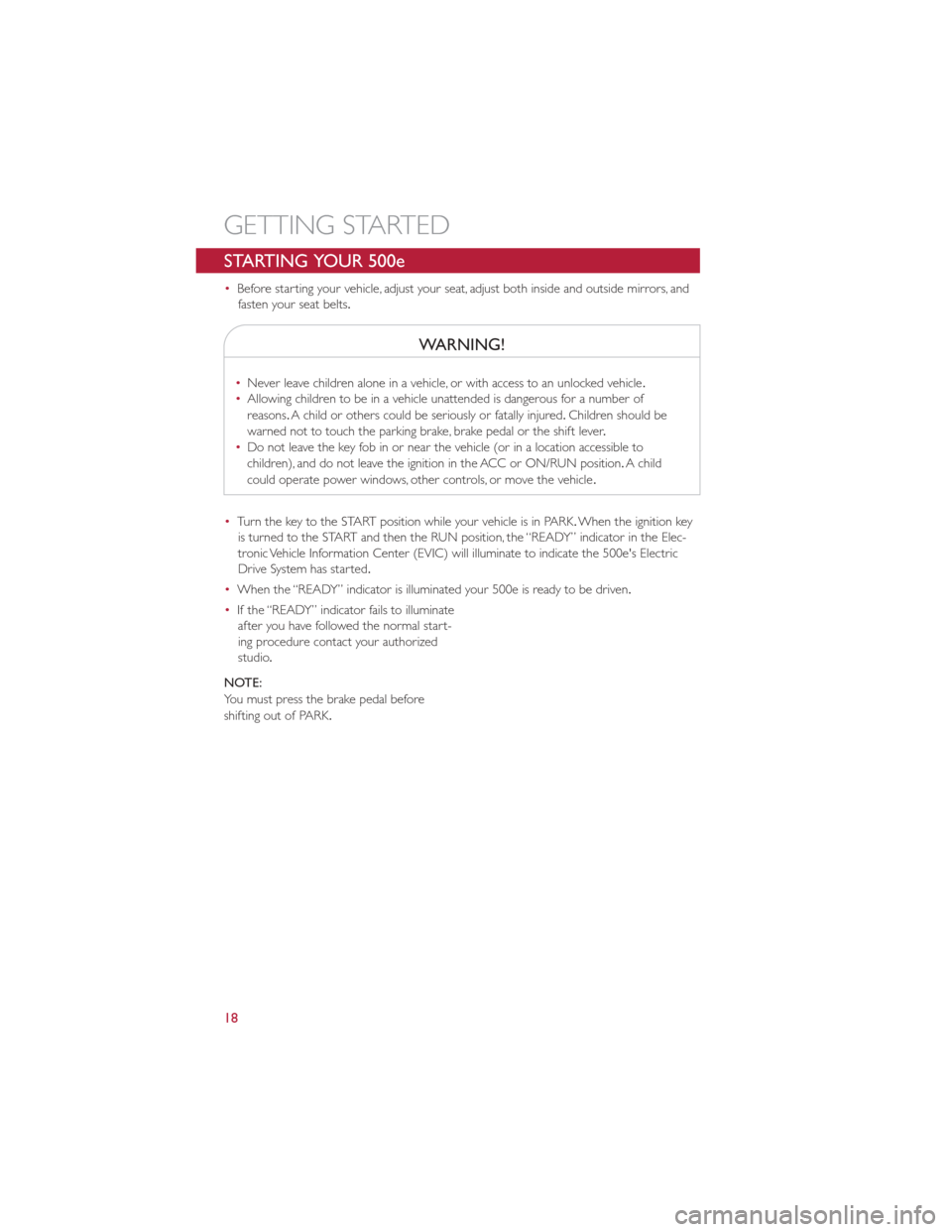
STARTING YOUR 500e
•Before starting your vehicle, adjust your seat, adjust both inside and outside mirrors, and
fasten your seat belts .
WARNING!
•Never leave children alone in a vehicle, or with access to an unlocked vehicle .
• Allowing children to be in a vehicle unattended is dangerous for a number of
reasons. A child or others could be seriously or fatally injured. Children should be
warned not to touch the parking brake, brake pedal or the shift lever .
• Do not leave the key fob in or near the vehicle (or in a location accessible to
children), and do not leave the ignition in the ACC or ON/RUN position. A child
could operate power windows, other controls, or move the vehicle .
• Turn the key to the START position while your vehicle is in PARK. When the ignition key
is turned to the START and then the RUN position, the “READY” indicator in the Elec-
tronic Vehicle Information Center (EVIC) will illuminate to indicate the 500e's Electric
Drive System has started.
• When the “READY” indicator is illuminated your 500e is ready to be driven.
• If the “READY” indicator fails to illuminate
after you have followed the normal start-
ing procedure contact your authorized
studio .
NOTE:
You must press the brake pedal before
shifting out of PARK.
GETTING STARTED
18
Page 21 of 84
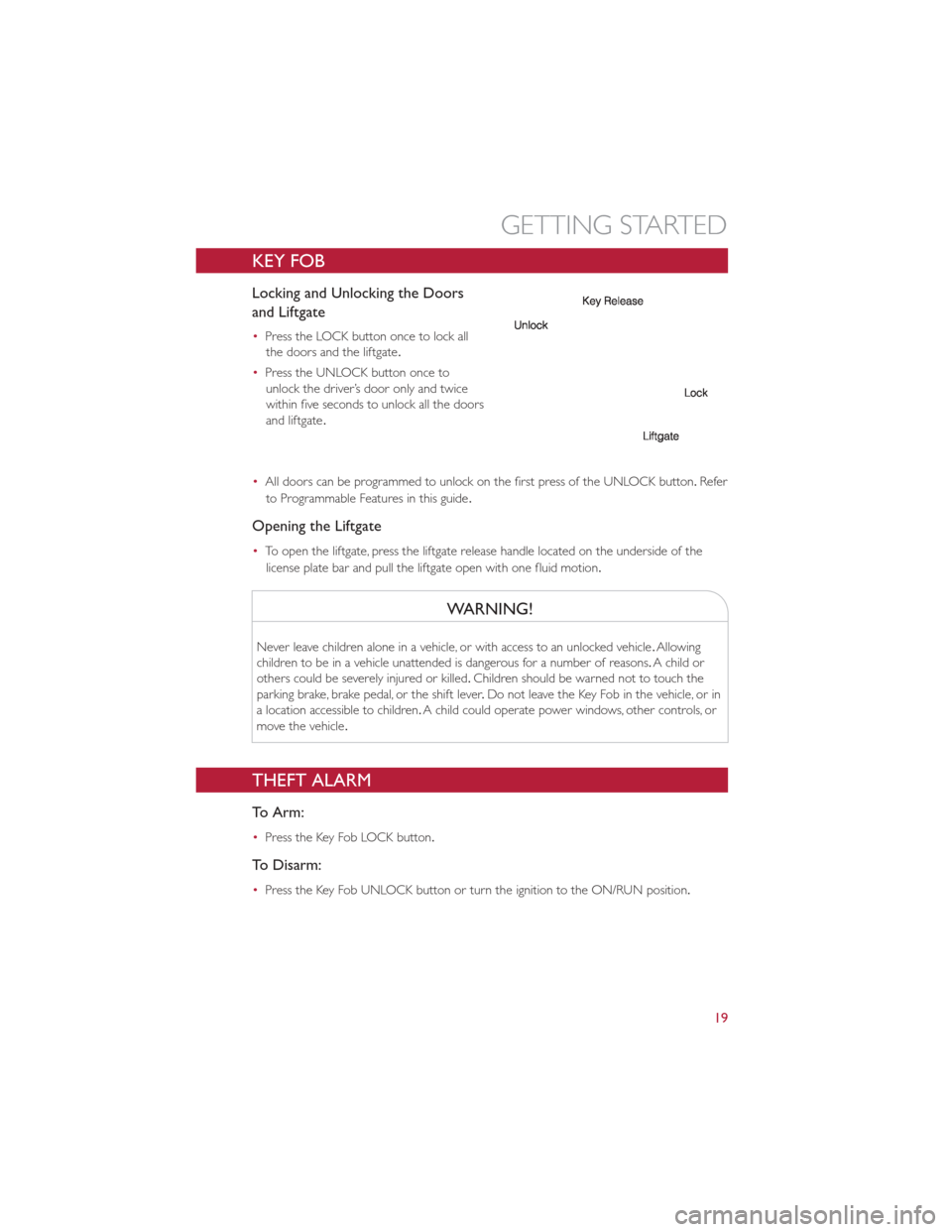
KEY FOB
Locking and Unlocking the Doors
and Liftgate
•Press the LOCK button once to lock all
the doors and the liftgate .
• Press the UNLOCK button once to
unlock the driver’s door only and twice
within five seconds to unlock all the doors
and liftgate .
• All doors can be programmed to unlock on the first press of the UNLOCK button. Refer
to Programmable Features in this guide .
Opening the Liftgate
•To open the liftgate, press the liftgate release handle located on the underside of the
license plate bar and pull the liftgate open with one fluid motion.
WARNING!
Never leave children alone in a vehicle, or with access to an unlocked vehicle .Allowing
children to be in a vehicle unattended is dangerous for a number of reasons. A child or
others could be severely injured or killed. Children should be warned not to touch the
parking brake, brake pedal, or the shift lever .Do not leave the Key Fob in the vehicle, or in
a location accessible to children. A child could operate power windows, other controls, or
move the vehicle .
THEFT ALARM
To Arm:
•Press the Key Fob LOCK button.
To Disarm:
•Press the Key Fob UNLOCK button or turn the ignition to the ON/RUN position.
GETTING STARTED
19
Page 22 of 84
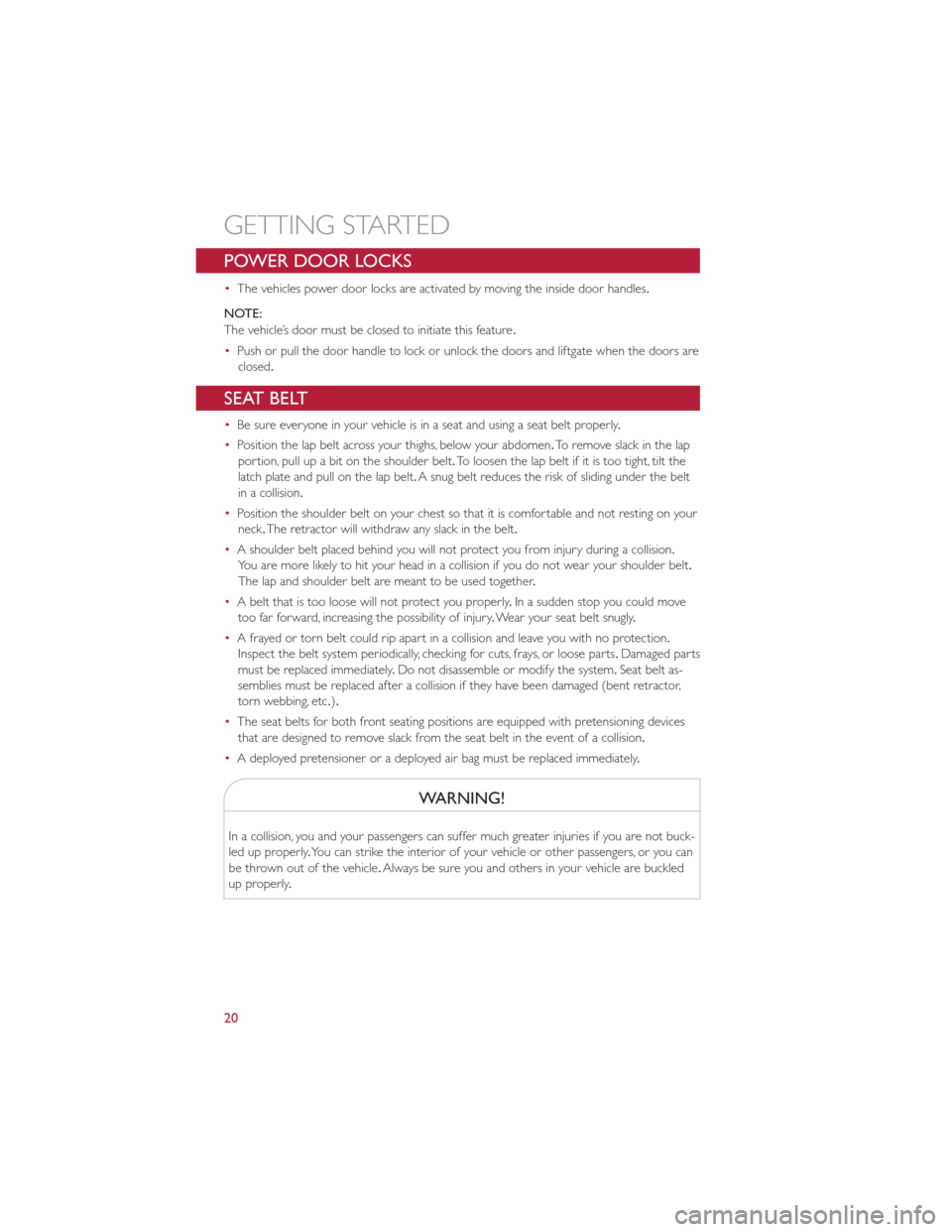
POWER DOOR LOCKS
•The vehicles power door locks are activated by moving the inside door handles.
NOTE:
The vehicle’s door must be closed to initiate this feature .
• Push or pull the door handle to lock or unlock the doors and liftgate when the doors are
closed.
SEAT BELT
• Be sure everyone in your vehicle is in a seat and using a seat belt properly .
• Position the lap belt across your thighs, below your abdomen. To remove slack in the lap
portion, pull up a bit on the shoulder belt. To loosen the lap belt if it is too tight, tilt the
latch plate and pull on the lap belt. A snug belt reduces the risk of sliding under the belt
in a collision.
• Position the shoulder belt on your chest so that it is comfortable and not resting on your
neck .The retractor will withdraw any slack in the belt.
• A shoulder belt placed behind you will not protect you from injury during a collision.
You are more likely to hit your head in a collision if you do not wear your shoulder belt.
The lap and shoulder belt are meant to be used together .
• A belt that is too loose will not protect you properly .In a sudden stop you could move
too far forward, increasing the possibility of injury .Wear your seat belt snugly .
• A frayed or torn belt could rip apart in a collision and leave you with no protection.
Inspect the belt system periodically, checking for cuts, frays, or loose parts .Damaged parts
must be replaced immediately .Do not disassemble or modify the system. Seat belt as-
semblies must be replaced after a collision if they have been damaged (bent retractor,
torn webbing, etc .).
• The seat belts for both front seating positions are equipped with pretensioning devices
that are designed to remove slack from the seat belt in the event of a collision.
• A deployed pretensioner or a deployed air bag must be replaced immediately .
WARNING!
In a collision, you and your passengers can suffer much greater injuries if you are not buck-
led up properly.You can strike the interior of your vehicle or other passengers, or you can
be thrown out of the vehicle .Always be sure you and others in your vehicle are buckled
up properly .
GETTING STARTED
20
Page 23 of 84
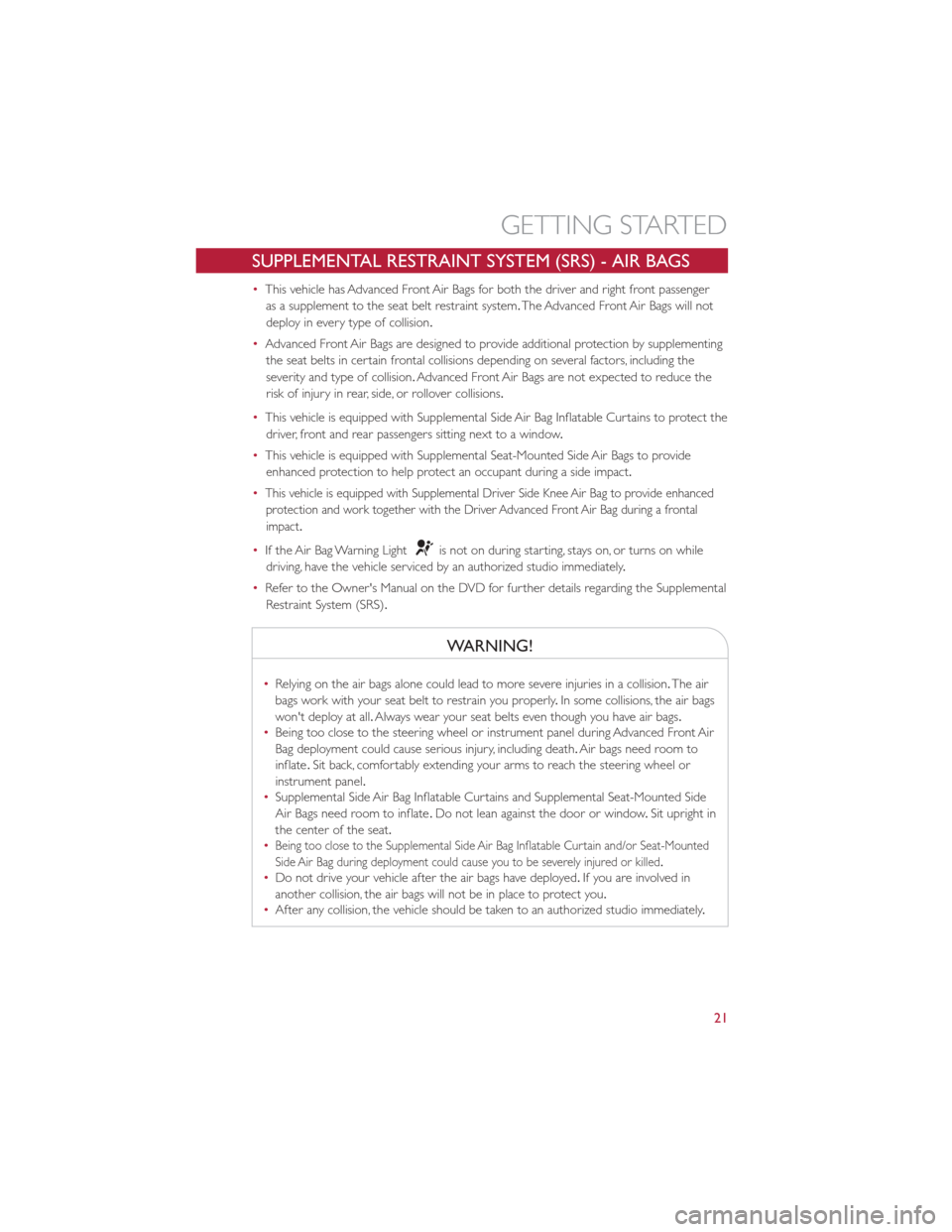
SUPPLEMENTAL RESTRAINT SYSTEM (SRS) - AIR BAGS
•This vehicle has Advanced Front Air Bags for both the driver and right front passenger
as a supplement to the seat belt restraint system. The Advanced Front Air Bags will not
deploy in every type of collision.
• Advanced Front Air Bags are designed to provide additional protection by supplementing
the seat belts in certain frontal collisions depending on several factors, including the
severity and type of collision. Advanced Front Air Bags are not expected to reduce the
risk of injury in rear, side, or rollover collisions.
• This vehicle is equipped with Supplemental Side Air Bag Inflatable Curtains to protect the
driver, front and rear passengers sitting next to a window .
• This vehicle is equipped with Supplemental Seat-Mounted Side Air Bags to provide
enhanced protection to help protect an occupant during a side impact.
•
This vehicle is equipped with Supplemental Driver Side Knee Air Bag to provide enhanced protection and work together with the Driver Advanced Front Air Bag during a frontal
impact.
• If the Air Bag Warning Lightis not on during starting, stays on, or turns on while
driving, have the vehicle serviced by an authorized studio immediately .
• Refer to the Owner's Manual on the DVD for further details regarding the Supplemental
Restraint System (SRS).
WARNING!
• Relying on the air bags alone could lead to more severe injuries in a collision. The air
bags work with your seat belt to restrain you properly .In some collisions, the air bags
won't deploy at all. Always wear your seat belts even though you have air bags .
• Being too close to the steering wheel or instrument panel during Advanced Front Air
Bag deployment could cause serious injury, including death. Air bags need room to
inflate .Sit back, comfortably extending your arms to reach the steering wheel or
instrument panel.
• Supplemental Side Air Bag Inflatable Curtains and Supplemental Seat-Mounted Side
Air Bags need room to inflate .Do not lean against the door or window .Sit upright in
the center of the seat.
•
Being too close to the Supplemental Side Air Bag Inflatable Curtain and/or Seat-Mounted
Side Air Bag during deployment could cause you to be severely injured or killed .
•Do not drive your vehicle after the air bags have deployed. If you are involved in
another collision, the air bags will not be in place to protect you.
• After any collision, the vehicle should be taken to an authorized studio immediately .
GETTING STARTED
21
Page 25 of 84
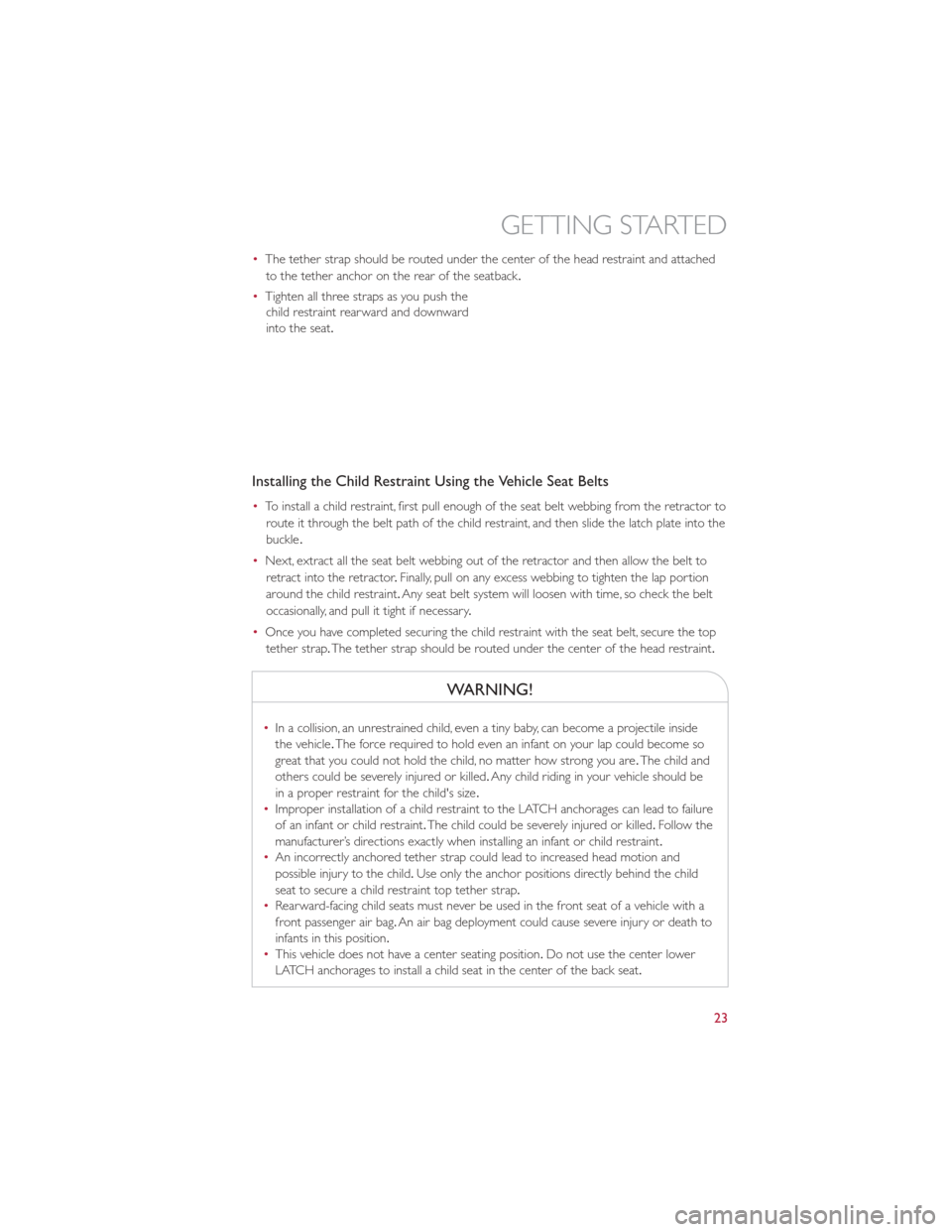
•The tether strap should be routed under the center of the head restraint and attached
to the tether anchor on the rear of the seatback .
• Tighten all three straps as you push the
child restraint rearward and downward
into the seat.
Installing the Child Restraint Using the Vehicle Seat Belts
• To install a child restraint, first pull enough of the seat belt webbing from the retractor to
route it through the belt path of the child restraint, and then slide the latch plate into the
buckle .
• Next, extract all the seat belt webbing out of the retractor and then allow the belt to
retract into the retractor .Finally, pull on any excess webbing to tighten the lap portion
around the child restraint. Any seat belt system will loosen with time, so check the belt
occasionally, and pull it tight if necessary .
• Once you have completed securing the child restraint with the seat belt, secure the top
tether strap .The tether strap should be routed under the center of the head restraint.
WARNING!
• In a collision, an unrestrained child, even a tiny baby, can become a projectile inside
the vehicle .The force required to hold even an infant on your lap could become so
great that you could not hold the child, no matter how strong you are .The child and
others could be severely injured or killed. Any child riding in your vehicle should be
in a proper restraint for the child's size .
• Improper installation of a child restraint to the LATCH anchorages can lead to failure
of an infant or child restraint. The child could be severely injured or killed. Follow the
manufacturer’s directions exactly when installing an infant or child restraint.
• An incorrectly anchored tether strap could lead to increased head motion and
possible injury to the child. Use only the anchor positions directly behind the child
seat to secure a child restraint top tether strap .
• Rearward-facing child seats must never be used in the front seat of a vehicle with a
front passenger air bag. An air bag deployment could cause severe injury or death to
infants in this position.
• This vehicle does not have a center seating position. Do not use the center lower
LATCH anchorages to install a child seat in the center of the back seat.
GETTING STARTED
23